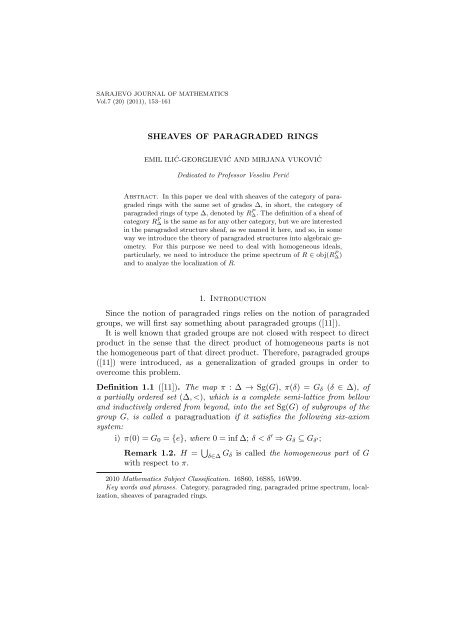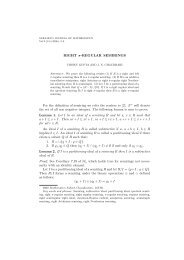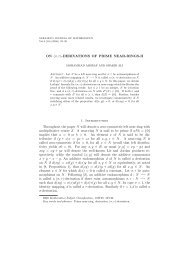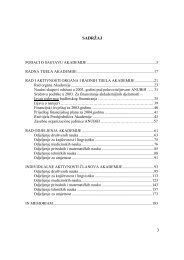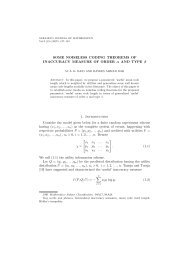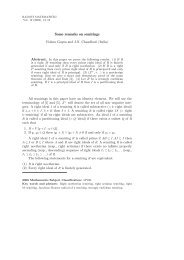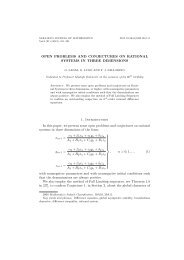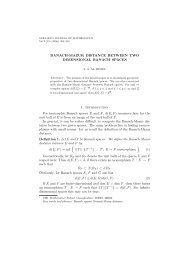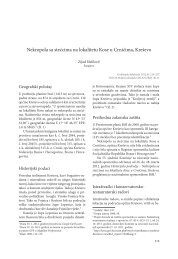Emil IliÄ-GeorgijeviÄ and Mirjana VukoviÄ - anubih
Emil IliÄ-GeorgijeviÄ and Mirjana VukoviÄ - anubih
Emil IliÄ-GeorgijeviÄ and Mirjana VukoviÄ - anubih
You also want an ePaper? Increase the reach of your titles
YUMPU automatically turns print PDFs into web optimized ePapers that Google loves.
SARAJEVO JOURNAL OF MATHEMATICS<br />
Vol.7 (20) (2011), 153–161<br />
SHEAVES OF PARAGRADED RINGS<br />
EMIL ILIĆ-GEORGIJEVIĆ AND MIRJANA VUKOVIĆ<br />
Dedicated to Professor Veselin Perić<br />
Abstract. In this paper we deal with sheaves of the category of paragraded<br />
rings with the same set of grades ∆, in short, the category of<br />
paragraded rings of type ∆, denoted by R∆. P The definition of a sheaf of<br />
category R∆ P is the same as for any other category, but we are interested<br />
in the paragraded structure sheaf, as we named it here, <strong>and</strong> so, in some<br />
way we introduce the theory of paragraded structures into algebraic geometry.<br />
For this purpose we need to deal with homogeneous ideals,<br />
particularly, we need to introduce the prime spectrum of R ∈ obj(R∆)<br />
P<br />
<strong>and</strong> to analyze the localization of R.<br />
1. Introduction<br />
Since the notion of paragraded rings relies on the notion of paragraded<br />
groups, we will first say something about paragraded groups ([11]).<br />
It is well known that graded groups are not closed with respect to direct<br />
product in the sense that the direct product of homogeneous parts is not<br />
the homogeneous part of that direct product. Therefore, paragraded groups<br />
([11]) were introduced, as a generalization of graded groups in order to<br />
overcome this problem.<br />
Definition 1.1 ([11]). The map π : ∆ → Sg(G), π(δ) = G δ (δ ∈ ∆), of<br />
a partially ordered set (∆,
154 EMIL ILIĆ-GEORGIJEVIĆ AND MIRJANA VUKOVIĆ<br />
Remark 1.3. If x ∈ H, we say that δ(x) = inf{ δ ∈ ∆ | x ∈ G δ }<br />
is the grade of x. We have δ(x) = 0 iff x = e. Elements δ(x), x ∈ H,<br />
are called principal grades <strong>and</strong> they form a set which we will denote<br />
by ∆ p .<br />
ii) θ ⊆ ∆ ⇒ ∩ δ∈θ G δ = G inf θ ;<br />
iii) If x, y ∈ H <strong>and</strong> yx = zxy, then z ∈ H <strong>and</strong> δ(z) ≤ inf{δ(x), δ(y)};<br />
iv) The homogeneous part H is a generating set of G;<br />
v) Let A ⊆ H be a subset such that for all x, y ∈ A there exists an<br />
upper bound for δ(x), δ(y). Then there exists an upper bound for all<br />
δ(x), x ∈ A;<br />
vi) G is generated by H with the set of H-internal <strong>and</strong> left commutation<br />
relations (see [11]).<br />
The group with paragraduation is called paragraded group.<br />
Definition 1.4 ([11]). The map π from Definition 1.1 which satisfies axioms<br />
i) − v) <strong>and</strong> the following axiom:<br />
vi’) Let δ 1 , . . . , δ s ∈ ∆ p be pairwise incomparable <strong>and</strong> let x i , x ′ i ∈ H (i =<br />
1, . . . , s) be such that x 1 · · · · · x s = x ′ 1 · · · · · x′ s <strong>and</strong> x i , x ′ i ∈ G δ i<br />
for<br />
all i = 1, . . . , s. Then δ(x −1<br />
i<br />
x ′ i ) < δ i.<br />
is called extragraduation. The group with extragraduation is called extragraded<br />
group.<br />
Remark 1.5 ([11]). It should be noticed that the fifth axiom is equivalent<br />
to the axiom:<br />
v’) Let A ⊆ H be a subset such that for all x, y ∈ A we have xy ∈ H.<br />
Then there exists δ ∈ ∆ such that A ⊆ G δ ;<br />
The following theorems are of great importance.<br />
Theorem 1.6 ([11]). Every extragraded group is a paragraded group.<br />
Theorem 1.7 ([11]). The direct product of paragraded groups is a paragraded<br />
group <strong>and</strong> the homogeneous part of the product is the product of<br />
homogeneous parts of the components.<br />
We will make use of the maps between the paragraded groups as well.<br />
Let G 1 <strong>and</strong> G 2 be two paragraded groups with sets of grades ∆ 1 <strong>and</strong> ∆ 2 ,<br />
<strong>and</strong> homogeneous parts H 1 <strong>and</strong> H 2 respectively.<br />
Definition 1.8 ([9]). We say that a homomorphism f : G 1 → G 2 is quasihomogeneous<br />
if<br />
(∀x ∈ H 1 ) f(x) ∈ H 2 .<br />
As we will see, we shall confine ourselves to the case ∆ 1 = ∆ 2 .
SHEAVES OF PARAGRADED RINGS 155<br />
Definition 1.9 ([9]). The ring (R, +, ·) is called paragraded if its additive<br />
group (R, +) is a paragraded group, with set of grades ∆, <strong>and</strong> if<br />
(∀ξ, η ∈ ∆)(∃ζ ∈ ∆) R ξ R η ⊆ R ζ .<br />
Definition 1.10 ([9]). If R is a paragraded ring, then the map (ξ, η) → ξη<br />
from ∆×∆ to ∆ is called a ∆-multiplication of grades if the following holds:<br />
a) R ξ R η ⊆ R ξη ;<br />
b) (∀ξ, ξ ′ , η, η ′ ∈ ∆) ξ ≤ ξ ′ ∧ η ≤ η ′ ⇒ ξη ≤ ξ ′ η ′ .<br />
If R is a paragraded ring, then there exists ζ = sup{ δ(z) | z ∈ R ξ R η }.<br />
If we put ζ = ξη, we will get ∆-multiplication <strong>and</strong> we call it the minimal<br />
multiplication ([9]).<br />
Definition 1.11 ([9]). Let R 1 <strong>and</strong> R 2 be two paragraded rings <strong>and</strong> f : R 1 →<br />
R 2 a homomorphism. We say that this homomorphism is quasihomogeneous<br />
if it is a quasihomogeneous homomorphism from a paragraded group (R 1 , +)<br />
to a paragraded group (R 2 , +).<br />
According to Theorem 1.7, the following theorem holds.<br />
Theorem 1.12 ([11]). The direct product of paragraded rings is a paragraded<br />
ring <strong>and</strong> the homogeneous part of the product is the product of homogeneous<br />
parts of the components.<br />
Paragraded rings with the same set of grades ∆, together with morphisms<br />
{ f ∈ hom(R, R ′ ) | f(R δ ) ⊆ R ′ δ , δ ∈ ∆ },<br />
form the category R∆ P . We call this category the category of paragraded rings<br />
of type ∆ ([4]).<br />
We will need some basic facts concerning sheaves. We begin with the<br />
definition of a protosheaf.<br />
Definition 1.13. A continuous map p : E → X, where E <strong>and</strong> X are<br />
topological spaces is called a local homeomorphism if for every e ∈ E there<br />
exists a neighborhood S of the element e, which is called a sheet, such that<br />
p(S) is an open set <strong>and</strong> p| S : S → p(S) a homeomorphism. The triple<br />
(E, p, X) is called a protosheaf if the local homeomorphism p is surjective.<br />
The space E is called a sheaf space, p its projection, <strong>and</strong> X a base space.<br />
For every x ∈ X, E x = p −1 (x) is called the stalk over x.<br />
Definition 1.14. Let X be a topological space. A presheaf of a category<br />
R∆ P over X is a function F which to every open set U ⊆ X assigns F(U) ∈<br />
R∆ P <strong>and</strong> to every pair of open sets V ⊆ U assigns a morphism, called a<br />
restriction,<br />
ρ U V : F(U) → F(V )
156 EMIL ILIĆ-GEORGIJEVIĆ AND MIRJANA VUKOVIĆ<br />
for which<br />
ρ U U = 1 U<br />
<strong>and</strong><br />
ρ U W = ρ V W ρ U V<br />
for all open W ⊆ V ⊆ U. In other words, a presheaf of category R∆ P is a<br />
contravariant functor F : U → R∆ P , where U is the category of open sets of<br />
X.<br />
It is known that a presheaf F is a sheaf if F satisfies an equalizer condition.<br />
For more details, see [16] <strong>and</strong> [15].<br />
2. The paragraded prime spectrum<br />
Let R be a paragraded ring with set of grades ∆.<br />
Definition 2.1. A homogeneous ideal P of the ring R is called prime homogeneous<br />
if P ≠ R <strong>and</strong> if for every two homogeneous ideals I, J from IJ ⊆ P<br />
follows that I ⊆ P or J ⊆ P.<br />
Theorem 2.2. A homogeneous ideal P of the ring R is prime homogeneous<br />
iff<br />
aRb ⊆ P ⇒ a ∈ P ∨ b ∈ P,<br />
for every a, b ∈ H.<br />
Proof. Let us assume that the ideal P is prime homogeneous <strong>and</strong> that<br />
aRb ⊆ P, where a, b ∈ H. Let A = RaR <strong>and</strong> B = RbR. Then A <strong>and</strong><br />
B are homogeneous ideals, for a <strong>and</strong> b are homogeneous elements. Now,<br />
AB ⊆ R(aRb)R ⊆ RP R ⊆ P, so, since P is a prime homogeneous, A ⊆ P<br />
or B ⊆ P. If A ⊆ P, then a ∈ P, <strong>and</strong> if B ⊆ P, then b ∈ P, which is easily<br />
verified as in the unparagraded case. The reverse statement is obvious. □<br />
Definition 2.3. The set of all prime homogeneous ideals of the ring R is<br />
called the paragraded spectrum <strong>and</strong> denoted by Spec pgr (R).<br />
3. Localization of paragraded rings<br />
Let R be a paragraded ring with the set of grades ∆ <strong>and</strong> with the homogeneous<br />
part H. We assume throughout this section that R is also a<br />
commutative ring with 1 ∈ H.<br />
We begin with a simple result.<br />
Lemma 3.1. If S is a multiplicative system of R, then S ∩ H is also a<br />
multiplicative system.<br />
Proof. If a, b ∈ S ∩ H, then a, b ∈ S <strong>and</strong> a, b ∈ H. Since S is a multiplicative<br />
system, we have ab ∈ S. But we also have ab ∈ H, because for the paragraded<br />
ring H 2 ⊆ H holds.<br />
□
SHEAVES OF PARAGRADED RINGS 157<br />
Let us now view R only as a ring <strong>and</strong> let S be its multiplicative system.<br />
Then, as we know, we may construct the ring of fractions S −1 R. According<br />
to Lemma 3.1, for a multiplicative system we may also take the set S ∩ H.<br />
Denote it again by S.<br />
Now, observe the map<br />
π S −1 R : δ → { a s | a ∈ R ξ, s ∈ R η , ηδ = ξ }<br />
(δ ∈ ∆).<br />
Proposition 3.2. If the minimal multiplication is associative <strong>and</strong> commutative,<br />
then the map π S −1 R is the paragraduation of the ring S −1 R.<br />
Proof. First we prove that π S −1 R(δ) is a subgroup of (S −1 R, +), δ ∈ ∆.<br />
Let a s , b t ∈ π S −1 R(δ). Then there exist ξ 1 , ξ 2 , η 1 , η 2 ∈ ∆ such that a ∈ R ξ1 ,<br />
b ∈ R ξ2 , s ∈ R η1 , t ∈ R η2 , <strong>and</strong><br />
η 1 δ = ξ 1 (3.1)<br />
η 2 δ = ξ 2 . (3.2)<br />
Now we have at ∈ R ξ1 R η2 ⊆ R ξ1 η 2<br />
, bs ∈ R ξ2 R η1 ⊆ R ξ2 η 1<br />
, hence from the<br />
associativity <strong>and</strong> commutativity of minimal multiplication <strong>and</strong> from one of<br />
the identities (3.1) or (3.2) it follows that at, bs ∈ R η1 η 2 δ, so at+bs ∈ R η1 η 2 δ.<br />
Also, st ∈ R η1 R η2 ⊆ R η1 η 2<br />
. Hence, a s + b t ∈ π S −1 R(δ).<br />
Axioms of paragraduation are easy to check if we take the properties of<br />
minimal multiplication <strong>and</strong> axioms of paragraduation which are satisfied<br />
for the ring R into account. For example, let us prove that from δ 1 < δ 2<br />
it follows that π S −1 R(δ 1 ) ⊆ π S −1 R(δ 2 ), for δ 1 , δ 2 ∈ ∆. Let a s ∈ π S −1 R(δ 1 ).<br />
Then there exist ξ, η ∈ ∆ such that a ∈ R ξ , s ∈ R η , <strong>and</strong> ηδ 1 = ξ. Since<br />
δ 1 < δ 2 , we have ηδ 1 < ηδ 2 , i.e. ξ < ηδ 2 . Hence, R ξ ⊆ R ηδ2 , so a ∈ R ηδ2 , i.e.<br />
a<br />
s ∈ π S −1 R(δ 2 ).<br />
Now let us prove that<br />
(∀ξ, η ∈ ∆)(∃ζ ∈ ∆) π S −1 R(ξ)π S −1 R(η) ⊆ π S −1 R(ζ)<br />
holds. If a s ∈ π S −1 R(ξ), <strong>and</strong> b t ∈ π S −1 R(η), then there exist λ 1 , λ 2 , θ 1 , θ 2 ∈ ∆<br />
such that a ∈ R λ1 , s ∈ R θ1 , b ∈ R λ2 , t ∈ R θ2 , θ 1 ξ = λ 1 <strong>and</strong> θ 2 η = λ 2 . Now,<br />
ab ∈ R λ1 R λ2 ⊆ R λ1 λ 2<br />
<strong>and</strong> st ∈ R θ1 R θ2 ⊆ R θ1 θ 2<br />
. Since<br />
we have ab<br />
st ∈ π S −1 R(ξη).<br />
θ 1 θ 2 ξη = (θ 1 ξ)(θ 2 η) = λ 1 λ 2 ,<br />
4. Sheaves of paragraded rings <strong>and</strong> the paragraded structure<br />
sheaf<br />
Definition 4.1. If X <strong>and</strong> E are topological spaces <strong>and</strong> p : E → X is a<br />
continuous map, then the triple S = (E, p, X) is called an etale-sheaf of the<br />
category R P ∆ if:<br />
□
158 EMIL ILIĆ-GEORGIJEVIĆ AND MIRJANA VUKOVIĆ<br />
i) (E, p, X) is protosheaf;<br />
ii) For all x ∈ X, E x = p −1 (x) ∈ R P ∆ ;<br />
iii) Inversion, addition <strong>and</strong> multiplication are continuous.<br />
Remark 4.2. Inversion is defined by e → −e, e ∈ E. Addition <strong>and</strong> multiplication<br />
are operations defined by (e, e ′ ) → e+e ′ <strong>and</strong> (e, e ′ ) → ee ′ , respectively,<br />
where (e, e ′ ) ∈ { (e, e ′ ) ∈ E × E | p(e) = p(e ′ ) } <strong>and</strong> the product topology is<br />
considered.<br />
Definition 4.3. If S = (E, p, X) is an etale-sheaf of the category R P ∆ <strong>and</strong><br />
U ⊆ X is an open set, then a section over U is a continuous map σ : U → E<br />
such that pσ = 1 U . If U = X, then a section over U is called a global section.<br />
Define Γ(∅, S) = {0} <strong>and</strong> Γ(U, S) to be the set of all the sections σ : U → E<br />
if U ≠ ∅.<br />
Proposition 4.4. Let S = (E, p, X) be etale-sheaf of the category R∆ P <strong>and</strong><br />
let F = Γ(−, S).<br />
i) F(U) ∈ R∆ P , for every open U ⊆ X.<br />
ii) F = Γ(−, S) is a presheaf of the category R∆ P , which is called the<br />
sheaf of sections of S.<br />
Proof. i) First we prove that F(U) ≠ ∅, for every open U ⊆ X. If U = ∅,<br />
then F(U) = {0}, according to definition, <strong>and</strong> hence F(∅) ≠ ∅. Now assume<br />
that ∅ ̸= U ⊆ X is an open set. If x ∈ U, pick e ∈ E x <strong>and</strong> a sheet S which<br />
contains e. Since p is an open map, p(S) ∩ U is an open neighborhood of x.<br />
The map p(S) → S ⊆ E is a section, <strong>and</strong> we denote by σ S its restriction on<br />
p(S) ∩ U. The family of such sets p(S) ∩ U forms an open cover of U, hence<br />
the maps σ S may be glued together to give a section from F(U). Hence,<br />
F(U) ≠ ∅, for every open U ⊆ X.<br />
Let σ, τ ∈ F(U). Then the map σ+τ, defined by (σ+τ)(x) := σ(x)+τ(x) is<br />
continuous, because, by definition, the maps σ <strong>and</strong> τ are continuous. Hence,<br />
σ + τ ∈ F(U). For the same reason, from σ ∈ F(U) it follows that −σ ∈<br />
F(U), which is defined in an obvious way. If we define στ(x) := σ(x)τ(x),<br />
then στ will also belong to F(U).<br />
Let σ ∈ F(U) be the section for which σ(x) is a homogeneous element,<br />
for all x ∈ U. Hence, for all x ∈ U, there exist δ ∈ ∆ <strong>and</strong> y ∈ X such that<br />
σ(x) ∈ π y (δ), for σ(x) ∈ E, <strong>and</strong> E = ∪ y∈X E y, where by π y we denoted<br />
the paragraduation of E y . These types of sections are called homogeneous<br />
sections. Let us define the map π : ∆ → Sg(F(U)) with<br />
π(δ) = { σ ∈ F(U) | (∀x ∈ U) σ(x) ∈ π x (δ) }.<br />
Now, let us observe π(0). Then π(0) is the set of all homogeneous sections<br />
σ for which σ(x) ∈ π x (0), for all x ∈ U. Since π y (0) = {0}, for all y ∈ X, we<br />
have σ(x) = 0, for all x ∈ U, hence σ = 0.
SHEAVES OF PARAGRADED RINGS 159<br />
Let δ 1 < δ 2 , δ 1 , δ 2 ∈ ∆. Let us assume that σ 1 ∈ π(δ 1 ). Then, σ 1 (x) ∈<br />
π x (δ 1 ), for all x ∈ U. Since π x (δ 1 ) ⊆ π x (δ 2 ), σ 1 (x) ∈ π x (δ 2 ), for all x ∈ U, so<br />
σ 1 ∈ π(δ 2 ). Hence, π(δ 1 ) ⊆ π(δ 2 ).<br />
If θ ⊆ ∆, observe ∩ δ∈θ π(δ). If σ ∈ ∩ δ∈θ<br />
π(δ), then for every x ∈ U,<br />
σ(x) ∈ π x (δ), for all δ ∈ θ, i.e. σ(x) ∈ ∩ δ∈θ π x(δ) = π x (inf θ), <strong>and</strong> hence<br />
σ ∈ π(inf θ).<br />
The third axiom of paragraduation is easily verified <strong>and</strong> the same holds<br />
for the fifth axiom. If σ ∈ F(U), then for all x ∈ U, σ(x) ∈ ∩ x∈U E x, <strong>and</strong><br />
E x = [H x ], hence homogeneous sections generate F(U).<br />
Since F(U) is generated by homogeneous sections <strong>and</strong> every image of a<br />
homogeneous section is generated via relations of paragraduation, the same<br />
holds for F(U).<br />
Let σ 1 ∈ π(ξ) <strong>and</strong> σ 2 ∈ π(η), where ξ, η ∈ ∆. Then for all x ∈ U,<br />
σ 1 (x) ∈ π x (ξ) <strong>and</strong> σ 2 (x) ∈ π x (η). Hence, σ 1 (x)σ 2 (x) ∈ π x (ξ)π x (η), for all<br />
x ∈ U. Since E x ∈ R∆ P , σ 1(x)σ 2 (x) ∈ π x (ξη), where ξη ∈ ∆ is a product by<br />
the laws of the minimal multiplication.<br />
ii) F is a contravariant functor U → R P ∆ .<br />
It is easy to see that all the presheaves of the category R∆ P , with morphisms<br />
defined in an obvious manner, form a category, denoted by pSh(X, R∆ P ). The<br />
category of all the sheaves of the category R∆ P , denoted by Sh(X, RP ∆<br />
), is<br />
defined to be the full subcategory of pSh(X, R∆ P ).<br />
Proposition 4.5. Let F, G ∈ pSh(X, R P ∆ ).<br />
i) If U is an open subset of X <strong>and</strong><br />
(F ⊕ G)(U) = F(U) ⊕ G(U),<br />
then F ⊕ G is a product <strong>and</strong> a coproduct of the category pSh(X, R P ∆ ).<br />
ii) If F <strong>and</strong> G are sheaves, then so is F ⊕ G <strong>and</strong> it is a product <strong>and</strong> a<br />
coproduct of the category Sh(X, R P ∆ ).<br />
Proof. i) If δ ∈ ∆, let us define the map π : ∆ → Sg(F(U) ⊕ G(U)) with<br />
π(δ) = π F(U) (δ) ⊕ π G(U) (δ),<br />
where by π F(U) <strong>and</strong> π G(U) we denote the paragraduations of F(U) <strong>and</strong> G(U),<br />
respectively. Then π is a paragraduation of the ring F(U)⊕G(U), (Theorem<br />
1.12) hence F(U) ⊕ G(U) ∈ R∆ P . It was proven in paper [5] that the category<br />
of paragraded modules of type ∆, M∆ P , has products <strong>and</strong> coproducts <strong>and</strong>,<br />
hence, the same holds true for R∆ P . The rest of the proof of this assertion<br />
relies upon the mentioned result in an obvious way <strong>and</strong> we shall omit it.<br />
□
160 EMIL ILIĆ-GEORGIJEVIĆ AND MIRJANA VUKOVIĆ<br />
ii) If F <strong>and</strong> G are sheaves, then the equalizer condition is satisfied for<br />
both F <strong>and</strong> G. Hence, the following sequence is exact.<br />
0 → (F ⊕ G)(U) α → ∏ i∈I<br />
(F ⊕ G)(U i ) β′ ,β ′′<br />
⇒<br />
∏<br />
(i,j)∈I×I<br />
where α : σ → (σ| Ui ), β ′ : σ i → σ i | U(i,j) , β ′′ : σ i → σ i | U(j,i) .<br />
(F ⊕ G)(U (i,j) ),<br />
Now, let us assume that R ∈ R∆ P is a commutative ring with 1 ∈ H<br />
<strong>and</strong> that the minimal multiplication is associative <strong>and</strong> commutative. Let<br />
X = Spec pgr (R). The same way as in the category of commutative rings,<br />
one can prove that X is a topological space with a base consisting of all the<br />
sets<br />
D(s) = { P ∈ Spec pgr (R) | s /∈ P }.<br />
To every set D(s) we may assign S −1 R, the ring of fractions with respect to<br />
S = {1, s, s 2 , . . . } ∩ H, which is an object of the category R∆ P according to<br />
Proposition 3.2. We denote this ring shortly by R s . The following statement<br />
is true (for proof, see [16]).<br />
Proposition 4.6. Suppose that X is a topological space <strong>and</strong> B a base for the<br />
topology. Let F be the data of a presheaf given only for open sets of the base,<br />
which satisfies the condition that whenever U = ∪ i∈I U i with U, U i ∈ B, the<br />
sequence<br />
F(U) → f ∏ F(U i ) g,h<br />
⇒<br />
∏<br />
F(U i ∩ U j )<br />
i∈I<br />
is an equalizer diagram, where<br />
(i,j)∈I×I<br />
f(s) = (ρ U U i<br />
(s)) i∈I ,<br />
g((s i ) i∈I ) = (ρ U i<br />
U i ∩U j<br />
(s i )) (i,j)∈I×I ,<br />
h((s i ) i∈I ) = (ρ U j<br />
U i ∩U j<br />
(s j )) (i,j)∈I×I .<br />
Then there is a sheaf G on X, unique up to isomorphism, such that<br />
(∀U ∈ B) Γ(U, G) = F(U)<br />
<strong>and</strong> the restriction maps F(U) → F(V ) <strong>and</strong> Γ(U, G) → Γ(V, G) agree for<br />
open V ⊆ U.<br />
The map F : B → R∆ P , defined by<br />
F(D(s)) = R s ,<br />
where B is the base of topology of X, satisfies the conditions of the previous<br />
Proposition, <strong>and</strong> hence, there exists a sheaf O of the category R∆ P over the<br />
□
SHEAVES OF PARAGRADED RINGS 161<br />
space X = Spec pgr (R), which is called the paragraded structure sheaf, for<br />
which we have<br />
Γ(D(s), O) = R s .<br />
References<br />
[1] S. Awodey, Category Theory, Clarendon Press, Oxford 2006.<br />
[2] N. Bourbaki, Algèbre, Chap. II, 3e édit. Paris, Hermann, 1962.<br />
[3] G. E. Bredon, Sheaf Theory, Springer-Verlag New York, 2nd ed. 1997.<br />
[4] E. Ilić-Georgijević, Some problems from the theory of paragraded structures, Ph. D.<br />
Thesis, University of East Sarajevo, 2011.<br />
[5] E. Ilić-Georgijević, On the categories of paragraded groups <strong>and</strong> modules of type ∆,<br />
(accepted in Sarajevo J. Math.).<br />
[6] E. Ilić-Georgijević, Some properties of paragraded modules of type ∆, (submitted).<br />
[7] E. Ilić-Georgijević, Tensor product of paragraded modules, (in preparation).<br />
[8] M. Krasner <strong>and</strong> M. Vuković, Structures paragraduées (groupes, anneaux, modules), I,<br />
Proc. Japan Acad. Ser, A, 62 (9) (1986), 350–352.<br />
[9] M. Krasner <strong>and</strong> M. Vuković, Structures paragraduées (groupes, anneaux, modules) II,<br />
Proc. Japan Acad. Ser, A, 62 (10) (1986), 389–391.<br />
[10] M. Krasner <strong>and</strong> M. Vuković, Structures paragraduées (groupes, anneaux, modules)<br />
III, Proc. Japan Acad. Ser, A, 63 (1) (1987), 10–12.<br />
[11] M. Krasner <strong>and</strong> M. Vuković, Structures paragraduées (groupes, anneaux, modules),<br />
Queen’s Papers in Pure <strong>and</strong> Applied Mathematics, No. 77, Queen’s University,<br />
Kingston, Ontario, Canada 1987, pp. 1–163.<br />
[12] S. Mac Lane, Categories for the Working Mathematician, Springer, 2nd ed. 1998.<br />
[13] C. Nǎstǎsescu <strong>and</strong> F. Van Oystaeyen, Methods of Graded Rings, Springer-Verlag,<br />
Berlin Heidelberg 2004.<br />
[14] V. Perić, Algebra I, IP Svjetlost, Sarajevo, 1991.<br />
[15] J. J. Rotman, An Introduction to Homological Algebra, Springer, 2nd ed. 2009.<br />
[16] B. R. Tennison, Sheaf Theory, Cambridge University Press, 1976.<br />
[17] M. Vuković, Structures graduées et paragraduées, Prepublication de l’Institut Fourier,<br />
Université de Grenoble I, No. 536 (2001), pp. 1–40.<br />
[18] M. Vuković, About Krasner’s <strong>and</strong> Vuković’s paragraduations, International Congress<br />
of Mathematicians, Hyderabad, India, 19-27 August 2010.<br />
(Received: July 15, 2011)<br />
(Revised: October 27, 2011)<br />
<strong>Emil</strong> Ilić-Georgijević<br />
Faculty of Civil Engineering<br />
University of Sarajevo<br />
E–mail: emil.ilic.georgijevic@gmail.com<br />
<strong>Mirjana</strong> Vuković<br />
Faculty of Natural Sciences <strong>and</strong> Mathematics<br />
University of Sarajevo<br />
E–mail: mirvuk48@gmail.com


